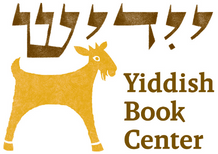October 2023: Handpicked
Each month, the Yiddish Book Center asks a member of our staff or a special friend to select favorite stories, books, interviews, or articles from our online collections. This month, we’re excited to share with you picks by David Mazower.

David Mazower is the chief curator and writer of the Center’s new permanent exhibition, Yiddish: A Global Culture. He is also the Center’s research bibliographer, with responsibility for books and other collections, co-editor of Pakn Treger, and editor of the blog Bronx Bohemians, about the salon of poet Bertha Kling. He writes for the Digital Yiddish Theatre Project and is the author of Yiddish Theatre in London, as well as dozens of published articles on Jewish history and art, Yiddish culture, and his great-grandfather Sholem Asch. Prior to joining the Center, David was a senior staff journalist with BBC World News in London and deputy curator of the Jewish Museum London. He graduated in history from Cambridge University and has a postgraduate diploma in Russian.
A bisl rekhiles (A Bit of Gossip)
Of the 12,000 books in our Steven Spielberg Digital Yiddish Library, this is apparently the only one with the word “gossip” in the title! Hard to believe, since Yiddish writers were a notoriously gossipy bunch, but there it is. Luckily, it’s a beauty—a gloriously irreverent record of one (doubtless gossip-filled) evening at the Warsaw Yiddish Writers’ Club. Check out the fabulous red cover on page 3 of the scan and the cute cartoon on page 5: Sholem Aleichem holds on to Peretz as he peers down from Mount Olympus in amazement at the sight of his young literary friend Hersh Dovid Nomberg tango dancing in the club (Nomberg was an obsessive dancer). The red cover image is one of the colorful new banners lining our main repository walkway in the new exhibition.
The Sholem Aleichem Funeral Album
Jewish New Yorkers gave Sholem Aleichem a truly epic send-off, as this memorial funeral album makes abundantly clear. The crowd of around 250,000 was by all accounts a record for the city, certainly up to 1916 and quite possibly ever since. The incredible photographs show mourners flooding the streets, crowding onto balconies, and clambering over monuments in the cemetery. The album also gives us a peek at Sholem Aleichem’s writing desk in the Bronx. Check out the pages of manuscript—I love the contrast between his small, neat handwriting and his crazy signature, like a fly’s flight path. As befits the Yiddish cultural icon par excellence, this album is on display in the Celebrities section of our new exhibition.
Crotona Park: A Yiddish Haven in the Bronx
Last year’s bibliography fellows were an exceptional bunch. They accomplished an enormous amount, not least helping to shape the new exhibition in myriad ways. But they also found time to write some great pieces for the Center’s website, including this one by Joseph Reisberg for the Bronx Bohemians blog. Our understanding of what constitutes Yiddish literary and cultural space has expanded significantly in recent years to encompass the café, salon, and sanatorium. Joey used the Center’s digital OCR search to great effect to add Crotona Park in the Bronx to that list. Editing the blog, collaborating on it with colleagues, and restoring Bertha Kling to her rightful place in New York Yiddish literary life has been a hugely rewarding project in recent years. Naturally, Kling makes it into the new exhibition too with a display case of wonderful ephemera donated by her granddaughter, Deborah Ramsden.
Writing the Story of Franya Winter
This is an example of the serendipity that has been a constant accompaniment to the final stages of work on the exhibition. I spent some considerable time browsing photo archives for a memorial display of Yiddish actors, representing the unimaginable loss suffered by the Yiddish theater profession in the Holocaust. One of those I selected was the Vilna star Franya Vinter (Winter). I knew nothing about her, but her smile lit up my screen, demanding to be included. Weeks later, I was astonished to see a review of a new book—author Meryl Frank’s remarkable quest to uncover the story of a theatrical cousin she had long been obsessed with. Her name? Franya Vinter. Listen to this podcast, buy the book, then come and see her in the exhibition.
Unruly Language: Czernowitz at 100 (Peretz’s Speech)
Peretz’s clarion call to the 1908 Czernowitz Yiddish language, in Marvin Zuckerman’s translation, is as powerful and relevant today as it was more than a century ago. It also shows why he was such an influential and magnetic writer and thinker. You can debate his analysis of the rise of Yiddish language and literature, but the clarity of his vision and his ability to reach out to an audience is mesmerizing. We’ve re-created Peretz’s salon in 1900s Warsaw in the new exhibition; you can step over the threshold, imagine yourself in the presence of so many great writers and artists and their charismatic mentor, and then hear their memories of that transformative experience.
Anthony Russell on Learning Sidor Belarsky’s Repertoire
Yiddish seems to have an endless capacity to attract new admirers and devotees. That’s just as well, since the language and culture have suffered a series of grievous blows in the twentieth century. Anthony Russell speaks eloquently about his powerful sense of connection to the performer Sidor Belarsky in this extract from his Wexler Oral History Project interview. That sense of a bridge to the past, the perennial remaking and reinvention of Yiddish, and the vibrant creativity of contemporary Yiddish artists are all threads running through the new exhibition.
Q&A
Tell us about your selections and what they say about your relationship with Yiddish language and culture.
Having spent much of the past five years working on Yiddish: A Global Culture, the Center’s new permanent exhibition, I wanted to highlight a few of the hundreds of stories, images, and objects that await you when you come and visit. The exhibition explores the rich history of the three foundational pillars of Yiddish mass culture—literature, theater, and the press. On top of that, we’ve added in a number of thematic displays, including Yiddish modernism, Yiddish bestsellers, women writers and their fight for recognition, the story of Yiddish in the Soviet Union, and an immersive re-creation of Peretz’s literary salon in Warsaw at the dawn of the twentieth century. Finally, we’ve created a backdrop of colorful installations—a sixty-foot mural of Yiddishland, a parade of vibrant overhead banners, and a montage of Yiddish music images.
What do my selections say about my relationship with Yiddish language and culture? So much of what’s in the exhibition is what I would love to encounter if I could travel back in time—the towering personalities, the packed theater shows, the extraordinary ferment and energy of Jewish Warsaw, New York, or Buenos Aires of a century ago. The popular imagination gets Yiddish so wrong; I hope the stories in Yiddish: A Global Culture enable visitors to connect with Yiddish culture in their own way, see Jewish history in a new light, and feel inspired to explore this great civilization further.
What are you working on next?
Well, very soon the Center will reopen and the exhibition will come alive with visitors. Memorable exhibitions shift our understanding and awareness by connecting to the emotions as well as the intellect, and I hope we’ve been able to do that here. At this point, I’m painfully aware of so much that we didn’t have room to include, and so one of the next steps is to develop online content that shares stories from the displays while allowing for some deeper dives. We have a slate of unfinished business—a timeline, an introductory gallery, and more—that constitutes phase two of the exhibition. We’d also love to publish an exhibition catalog that allows you to savor the exhibition in a single volume in your own time. That’s just a matter of time and money. Beyond that, the collections are always in need of attention. We’ve transformed our rare book, music, and typewriter collections in the past few years, with many treasures from that process finding their way into the new exhibition. The next priorities are our journals, periodicals, and type materials. And then there’s Pakn Treger. And the Bronx Bohemians blog. Un nokh un nokh . . .
